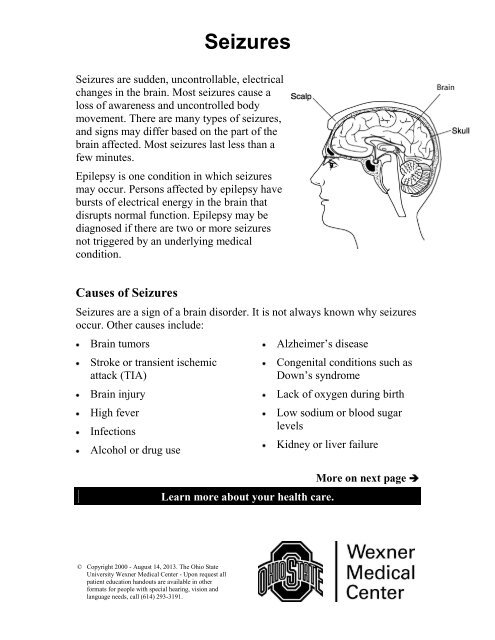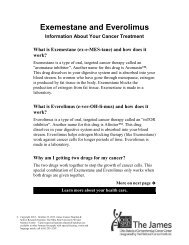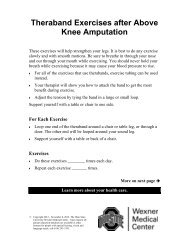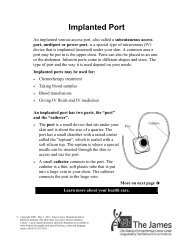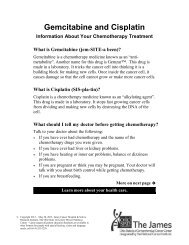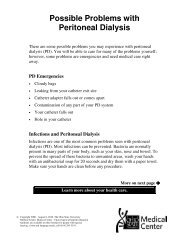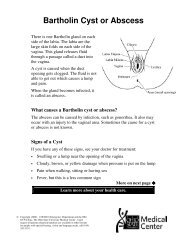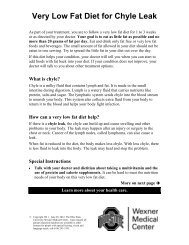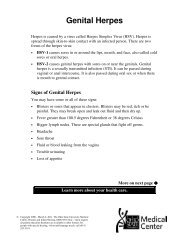Seizures - Patient Education Home
Seizures - Patient Education Home
Seizures - Patient Education Home
You also want an ePaper? Increase the reach of your titles
YUMPU automatically turns print PDFs into web optimized ePapers that Google loves.
<strong>Seizures</strong><br />
<strong>Seizures</strong> are sudden, uncontrollable, electrical<br />
changes in the brain. Most seizures cause a<br />
loss of awareness and uncontrolled body<br />
movement. There are many types of seizures,<br />
and signs may differ based on the part of the<br />
brain affected. Most seizures last less than a<br />
few minutes.<br />
Epilepsy is one condition in which seizures<br />
may occur. Persons affected by epilepsy have<br />
bursts of electrical energy in the brain that<br />
disrupts normal function. Epilepsy may be<br />
diagnosed if there are two or more seizures<br />
not triggered by an underlying medical<br />
condition.<br />
Causes of <strong>Seizures</strong><br />
<strong>Seizures</strong> are a sign of a brain disorder. It is not always known why seizures<br />
occur. Other causes include:<br />
Brain tumors<br />
Stroke or transient ischemic<br />
attack (TIA)<br />
Brain injury<br />
High fever<br />
Infections<br />
Alcohol or drug use<br />
Alzheimer’s disease<br />
Learn more about your health care.<br />
Congenital conditions such as<br />
Down’s syndrome<br />
Lack of oxygen during birth<br />
Low sodium or blood sugar<br />
levels<br />
Kidney or liver failure<br />
More on next page <br />
© Copyright 2000 - August 14, 2013. The Ohio State<br />
University Wexner Medical Center - Upon request all<br />
patient education handouts are available in other<br />
formats for people with special hearing, vision and<br />
language needs, call (614) 293-3191.
Page 2<br />
Signs of Seizure<br />
Aura<br />
An aura is a warning sign right before the seizure. The aura may be a<br />
headache, changes in vision, hearing noises or smelling a scent such as<br />
smoke.<br />
During the Seizure<br />
Other signs may occur during the seizure, such as:<br />
Staring spells<br />
Facial twitching<br />
Problems breathing<br />
Black outs, loss of memory or confusion<br />
Drooling<br />
Problems controlling the bowels or bladder<br />
Convulsions or uncontrollable body motions such as chewing motions,<br />
body stiffening, jerking or lip smacking<br />
Changes in sensation or vision<br />
If the person has never had a seizure before or if the seizure lasts<br />
longer than 5 minutes, call 911 right away. A person with epilepsy<br />
should always wear a medical alert necklace or bracelet.<br />
After the Seizure<br />
The time after the seizure and before the person wakes up is called the<br />
postictal state. Most people are very tired and confused during this time.<br />
If possible, write down what happens during the seizure. Include the<br />
date, how long it lasted, and exactly what happened. Share this<br />
information with the doctor. If the person has epilepsy, medicines or<br />
other treatments may need changed.<br />
Ask for the handout, How to Help Someone Having a Seizure, to learn how<br />
to help someone during and after a seizure.
Page 3<br />
Types of <strong>Seizures</strong><br />
The two main types of seizures are:<br />
Generalized seizures (absence, atonic, tonic-clonic and myoclonic)<br />
Partial seizures (simple and complex)<br />
Knowing the type of seizure the person has helps the doctor find the best<br />
treatment.<br />
Generalized <strong>Seizures</strong><br />
Both sides of the brain are affected.<br />
Absence seizure, also called a petit mal seizure, involves a staring spell.<br />
This type is most often seen in people under 20 years old. The person<br />
may have no memory of the seizure. The person may stop walking or<br />
talking in mid-sentence and start again in a few seconds.<br />
Atonic seizure causes a sudden fall. Injury can result from hitting the<br />
face or head.<br />
Tonic-clonic seizure, also called a grand mal seizure, involves the<br />
whole body. This is the most common type of generalized seizure. It<br />
often starts with a cry before the person blacks out. Convulsions, tongue<br />
biting, frothy saliva around the mouth, bed-wetting and problems with<br />
breathing may occur.<br />
Myoclonic seizure involves quick, involuntary twitching of the<br />
muscles.<br />
Partial <strong>Seizures</strong><br />
One part of the brain is affected.<br />
Simple partial seizure: The person knows what is happening, but is not<br />
able to control it.<br />
Complex partial seizure: The person does not know what is happening<br />
and may look or act confused during and after the seizure.<br />
When a partial seizure leads to a generalized seizure, it is called a<br />
secondary generalized seizure. The seizure starts in one part of the brain,<br />
but spreads to another part of the brain. For some people, the partial seizure<br />
acts as an aura or warning sign. It can give the person enough time to get to<br />
a safe place before he or she blacks out.
Page 4<br />
Testing and Treatment<br />
The doctor will ask about signs and check to see if there is a medical<br />
problem that caused the seizure. One or more of these tests may be ordered:<br />
Electroencephalogram (EEG): This is the most common test for<br />
epilepsy. It looks for abnormal brain activity.<br />
The doctor may recommend a hospital stay and monitoring in the<br />
Epilepsy Monitoring Unit. The person is watched during a seizure event<br />
while the EEG records brain activity and a video camera records<br />
physical activity.<br />
Brain scans: Computerized tomography (CT) scan and magnetic<br />
resonance imaging (MRI) look at the structure of the brain. A PET scan<br />
checks the brain’s activity and finds problems in how it works. A brain<br />
SPECT scan measures blood flow in the brain. A scan done during a<br />
seizure and one done between seizures are compared so that the part of<br />
the brain where the seizures start can be found.<br />
Blood tests: Blood samples may be taken to check for causes or triggers<br />
of seizure such as infections, lead poisoning, anemia and diabetes.<br />
Lumbar puncture: A sample of fluid from the space that surrounds the<br />
spinal cord and nerve roots is checked to see if an infection is the cause<br />
of the seizure.<br />
Other tests may be done to measure motor skills, behavior and cognition<br />
to see how the epilepsy is affecting the person.<br />
A seizure caused by a high fever or a certain medicine is treated by<br />
removing the cause. A new seizure with an unknown cause will need tests<br />
to determine treatment. For the person with epilepsy, a seizure may be a<br />
sign that his or her medicine may need changed.<br />
Anti-epileptic medicines may be prescribed to control seizures. Surgery<br />
may be needed to help decrease seizures. Some patients need to wear<br />
helmets to prevent head injuries.<br />
Living with <strong>Seizures</strong><br />
<strong>Seizures</strong> can affect daily living, self-esteem and freedom in daily activities.<br />
If you have depression, trouble sleeping, trouble eating or functioning, talk<br />
with your doctor. A referral for personal and/or family counseling may help<br />
to address quality of life issues. Seek out support groups to share<br />
experiences, frustrations and tips on how to cope with seizures.
Page 5<br />
Driving and Other Activities:<br />
Each state has driving laws that cover people who have seizures. If seizures<br />
are not controlled, he or she cannot drive. Most states require that the<br />
person not have a seizure for a certain amount of time, such as six months.<br />
A note from the doctor may be needed stating that the seizures are<br />
controlled and the person is safe to drive. Or, the person may be able to get<br />
a restricted license to drive under certain conditions. For example, a person<br />
who suffers from seizures at night would be able to drive during the day<br />
only. In Ohio, call the Bureau of Motor Vehicles at (614) 752-7500 or<br />
TDD (614) 752-4559 for more information.<br />
A person with uncontrolled seizures should also avoid activities where a<br />
seizure could cause serious injury. Examples include climbing, biking, and<br />
swimming alone.<br />
Important Considerations:<br />
Talk to your doctor about birth control and other hormone treatment if<br />
you have seizures. Interactions can occur between medicines used to<br />
control seizures and birth control.<br />
Talk with your doctor if you are pregnant, are planning a pregnancy or<br />
breastfeeding. The frequency of seizures may change with pregnancy,<br />
and there may be at greater risk for some complications. During and<br />
after pregnancy, the amount or dose of seizure medicine may need to be<br />
changed. Do not stop taking seizure medicine during pregnancy<br />
unless directed by your doctor.<br />
The frequency of seizures may change over time. Aging, menopause,<br />
stress and other changes in health can affect the dose of seizure<br />
medicine needed to control your signs.<br />
Some seizure medicines can cause mineral loss from bone. This can<br />
lead to osteoporosis and bone fractures. Eat a diet high in calcium and<br />
vitamin D, do weight-bearing exercises, and avoid alcohol and smoking.<br />
For more information about seizures, visit these resources:<br />
<strong>Patient</strong> <strong>Education</strong> handout “Women with Epilepsy”<br />
Epilepsy Foundation, www.epilepsyfoundation.org<br />
National Institute of Neurological Disorders and Stroke,<br />
www.ninds.nih.gov


